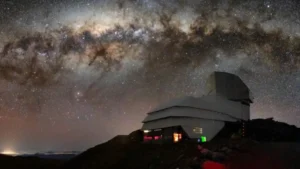Mars is known for its expansive, rust-colored deserts. Its sunsets? Maybe not so much. But that could change thanks to the Mars Curiosity Rover.
Curiosity is in the middle of a two-and-a-half-month-long cloud survey mission using its color-capable Mast Camera. It’s the first Curiosity cloud survey in color. Past surveys have used the rover’s black-and-white navigation camera. The full-color results are ethereal and pearlescent.

The sun’s rays illuminate a cloud bank on Mars, a recent capture by the Mars Curiosity Rover. Photo: NASA/JPL-Caltech/MSSS/SSI
The Feb. 2 photo’s eerie nature results from several factors: time of day (twilight) combined with high-altitude clouds comprised mostly of carbon dioxide ice. The patterns on display here are known as crepuscular rays.
“Where we see iridescence, it means a cloud’s particle sizes are identical to their neighbors in each part of the cloud,” said Mark Lemmon, an atmospheric scientist with the Space Science Institute in Boulder, Colorado in a NASA press release. “By looking at color transitions, we’re seeing particle size changing across the cloud. That tells us about the way the cloud is evolving and how its particles are changing size over time.”
NASA stitched the panorama-style photo together from 28 separate images. And this isn’t the first haunting image Curisoity’s produced in pursuit of its latest mission.
On Jan. 27, the rover captured a feather-shaped cloud displaying similar iridescence.

An iridescent cloud captured on Jan. 27. Photo: NASA/JPL-Caltech/MSSS
Studying clouds allows scientists to understand the way that weather works on Mars. It’s a crucial mission, given NASA’s goal of conducting manned excursions on the Red Planet in the coming decades.
Built by NASA’s Jet Propulsion Laboratory, Curiosity has been chugging around performing experiments and collecting data on Mars for over 3,000 Martian days.






